Are you tired of constantly worrying about your outward opening door being vulnerable to intruders? Worry no more because this guide will teach you how to secure an outward opening door.
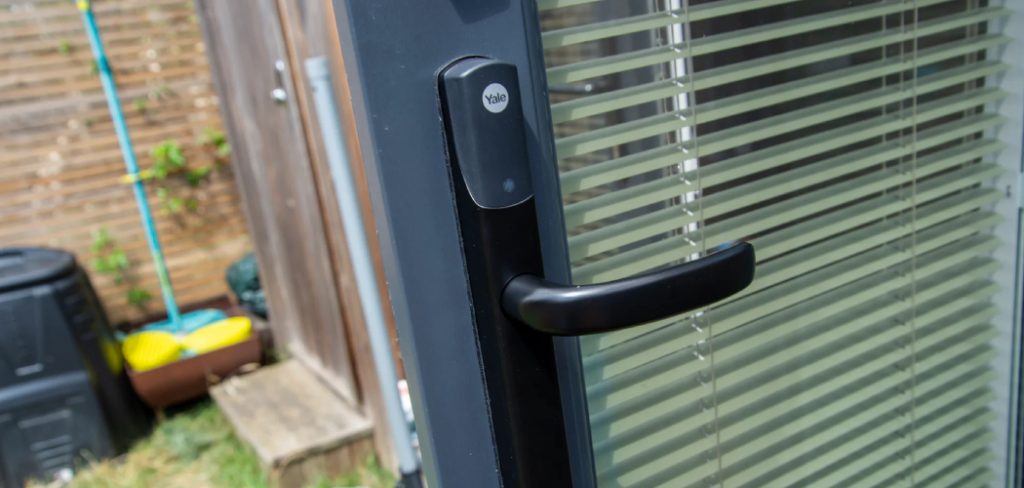
Securing an outward-opening door presents unique challenges compared to its inward-swinging counterparts, largely due to the exposed hinges and the potential for forceful entry from the outside. However, with a thoughtful approach and the right hardware, these obstacles can be effectively overcome, enhancing the security of homes, offices, and other properties.
This guide will walk you through essential strategies and products designed to fortify outward-opening doors against unauthorized access, offering peace of mind through increased safety and protection. Whether you are looking to upgrade the security of a residential entryway or seeking to safeguard a commercial premise, understanding how to properly secure an outward-opening door is a crucial step in your overall security plan.
What are the Benefits of Securing an Outward Opening Door?
Securing an outward-opening door has several benefits, making it a worthwhile investment. Here are some of the key advantages:
- Improved Security: The primary benefit of securing an outward opening door is enhancing your property’s overall security and safety. With the right measures in place, your door will be less vulnerable to forced entry and break-ins, providing you with peace of mind.
- Deterrent to Intruders: A secured outward-opening door is a visual deterrent to potential intruders. Knowing that the door is reinforced and difficult to breach can discourage them from attempting a break-in in the first place.
- Increased Privacy: By securing an outward opening door, you also enhance your privacy, as it becomes more challenging for anyone to see inside your home or office. This can be especially beneficial for ground-level entrances or doors facing public areas.
- Energy Efficiency: A properly secured outward opening door can also improve energy efficiency by preventing drafts and air leaks. This not only helps with temperature control but also reduces energy costs in the long run.
These are just some of the main benefits of securing an outward opening door, making it a necessary step for any property owner looking to improve their security and peace of mind. Now let’s dive into some practical tips on how to secure these doors effectively.
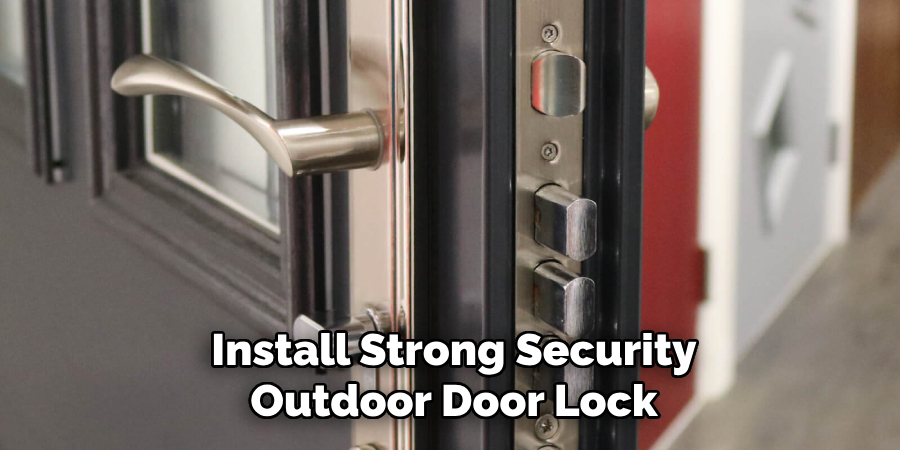
What Will You Need?
Before we get started, here are some essential tools and hardware you will need to secure an outward opening door:
- Hinge Bolts: These specialized bolts attach the hinge side of the door to the frame, making it much stronger and less susceptible to forced entry.
- A Deadbolt Lock: A high-quality deadbolt lock is essential for securing an outward-opening door. Look for heavy-duty locks with reinforced steel construction and anti-pick features.
- Door Reinforcement Plates: These metal plates are designed to reinforce weak points on the door frame, such as where the deadbolt is inserted. They help spread force evenly across the frame, making it more resistant to break-ins.
- Security Strike Plate: This is an upgraded version of a standard strike plate and includes additional screws for added strength. It also has an anti-kick feature that helps prevent the door from being kicked in.
With these tools and hardware in hand, you are now ready to start securing your outward-opening door.
10 Easy Steps on How to Secure an Outward Opening Door:
Step 1. Install Hinge Bolts:
Begin by installing hinge bolts, which are critical for securing the hinge side of an outward opening door. Because the hinges are exposed, securing them with hinge bolts will make it much more difficult for an intruder to remove the door. Drill holes for the hinge bolts into the door frame and the door itself, then screw the bolts in tightly.
Step 2. Upgrade to a High-Security Deadbolt:
Replace your existing lock with a high-security deadbolt lock. A quality deadbolt is one of the most effective defenses against door breach attempts. When selecting a deadbolt, ensure it has a Grade 1 certification from the American National Standards Institute (ANSI) for residential use.

Install the deadbolt according to the manufacturer’s instructions, ensuring it aligns properly with the door frame to maximize its effectiveness. This upgrade significantly enhances the door’s resistance to forced entry, making it a formidable barrier against intruders.
Step 3. Attach Door Reinforcement Plates:
The next step is strengthening the door by attaching door reinforcement plates around the lock area. These plates work by providing an additional layer of metal to prevent the door from splitting or giving way around the lock mechanism under pressure.
Measure the area around your existing lock to ensure you purchase a reinforcement plate that fits perfectly. Installation is straightforward—remove the lock, place the reinforcement plate over the area, and then reattach the lock over the plate. This simple upgrade substantially increases the resilience of your door against forced attacks.
Step 4. Secure the Door Frame with a Security Strike Plate:
A crucial area to fortify is where the deadbolt lock meets the door frame. To enhance security at this vital point, install a security strike plate. These plates are made from heavy-duty metals and come with long screws that anchor deep into the door frame and wall studs, offering significant resistance to forceful entry attempts.
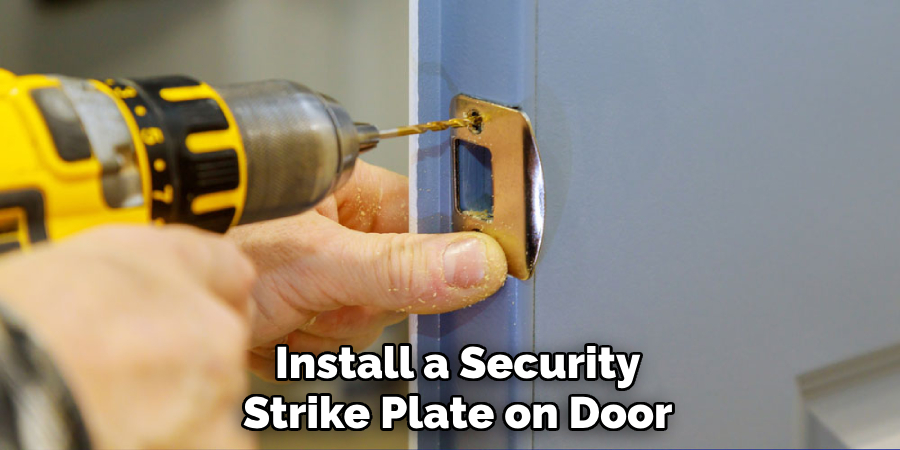
When installing a security strike plate, make sure to remove the existing plate and replace it with the security version using the longer screws provided. This ensures that the door frame becomes a robust barrier, working with your deadbolt lock to prevent intruders from breaking through.
Step 5. Install a Door Barricade or Security Bar:
To further enhance the security of your outward opening door, consider installing a door barricade or security bar. These devices offer an additional layer of protection, making it significantly more challenging for an intruder to force the door open. Door barricades are installed on the floor and can be engaged to block the door from opening.
Security bars are mounted on the door or frame and can be adjusted to brace against the floor or the frame, preventing the door from being opened forcibly. Opt for a heavy-duty, easy-to-use model that can be engaged quickly in an emergency. Installation varies based on the type of device but typically involves securing the hardware to the floor or door with strong screws. This step is crucial for those seeking maximum security, especially in high-risk areas.
Step 6. Add a Peephole or Security Camera:
Consider installing a peephole or a security camera for an additional security layer. A peephole allows you to see who is at your door without having to open it. At the same time, a security camera provides a visual record of visitors, which can be vital in the event of an attempted break-in. Select a wide-angle peephole for a broader view of the area outside your door.
If choosing a security camera, opt for a night vision and motion detection model to ensure 24/7 surveillance. Installation of a peephole is relatively straightforward and requires drilling a hole through the door at an appropriate height, while setting up a security camera might require a more technical setup, depending on the model and connectivity options.
Step 7. Illuminate the Door Area with Motion-Sensor Lighting:
Improving visibility around your outward opening door is paramount for deterring potential intruders. Installing motion-sensor lighting is an effective way to achieve this. These lights automatically turn on when movement is detected, illuminating the area and making it less inviting for someone attempting to break in under cover of darkness.
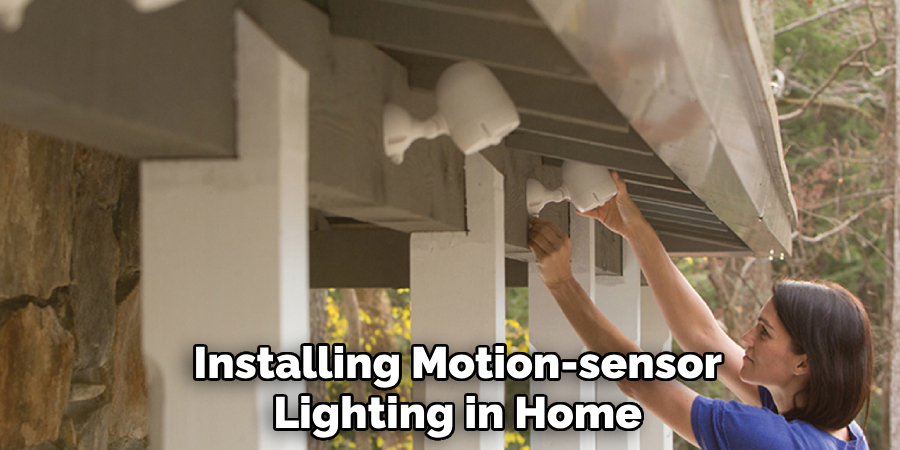
Choose a weather-resistant lighting system that covers a broad area to ensure maximum effectiveness. The installation process typically involves mounting the light fixture to the wall and connecting it to a power source, which may require some basic electrical skills. Motion-sensor lights not only enhance security but also provide convenience by lighting your path as you approach the door.
Step 8. Use Window Security Film on Door Windows:
If your outward opening door has glass panels or windows, applying a security film can significantly enhance its resistance to break-ins. Security film is a clear, polyester layer that, when applied to glass, makes it more difficult to shatter. This discourages intruders by requiring them to exert much more effort to break the glass, potentially deterring them entirely due to the increased risk of detection.
Select a film that provides a strong adhesive bond and offers UV protection to prevent the glass from shattering into sharp, dangerous pieces. Installation involves cleaning the glass thoroughly, cutting the film to size, and applying it smoothly to avoid bubbles, which may require patience and precision.
This step is particularly useful for doors with windows, as it maintains the door’s aesthetic appeal while significantly boosting its security profile.
Step 9. Regular Maintenance and Inspection:
Regular maintenance and inspection are key to ensuring that all the security upgrades you’ve implemented remain effective over time. Periodically check all installed hardware, such as deadbolts, reinforcement plates, strike plates, barricades, and security bars, to ensure they are tight and in good working order.
Pay special attention to screws and fixtures to confirm they haven’t loosened. For electronic devices like security cameras and motion-sensor lights, test them to ensure they are operational and that their settings are optimized for security. It’s also wise to inspect the door, frame, and surrounding areas for any signs of wear or damage that could compromise security.
This proactive approach helps identify potential vulnerabilities before an intruder can exploit them.
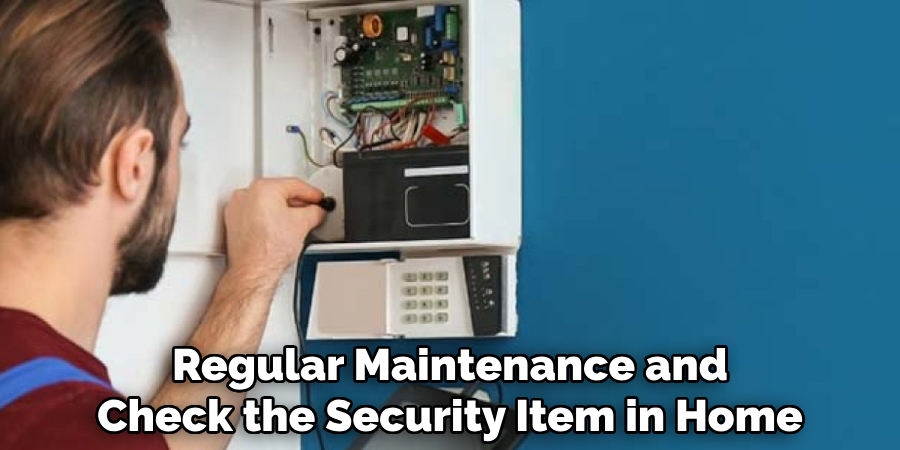
Step 10. Employ Smart Lock Technology:
Incorporating smart lock technology is a forward-thinking step in enhancing your door’s security. Smart locks provide keyless entry options and offer features like remote access, allowing you to lock or unlock your door from anywhere using a smartphone app.
Many models also include access logs, which track who enters and exits and at what times, adding an additional layer of security through monitoring. When selecting a smart lock, choose one that is compatible with your current door setup and that integrates seamlessly with other home security systems you may have in place. Installation varies by model but often involves replacing the existing lock or adding a new mechanism over it.
Opting for a smart lock with robust encryption and security protocols is crucial to prevent unauthorized access through hacking. By following these ten steps, you can significantly increase the security of your outward opening door and better protect your home and loved ones.
5 Additional Tips and Tricks
- Install Hinge Bolt Pins: The hinges of an outward-opening door are vulnerable because they are accessible from the outside. Installing high-quality hinge bolt pins can prevent the door from being lifted off its hinges, even if the pins are tampered with.
- Use a High-Security Door Frame: Reinforcing the door frame using a steel door frame or using frame strengtheners can dramatically increase the resistance against forced entry. It ensures that the door, along with its secure locks and hinges, remains intact even under substantial force.
- Fit a Latch Guard: A latch guard covers the gap between the door and the frame, making it difficult for an intruder to pry the door open with a crowbar or similar tool. This metal plate adds an extra layer of security for outward opening doors.
- Incorporate a Lock with a Deadbolt: Installing a deadbolt lock that extends deep into the door frame can significantly enhance a door’s security. For outward opening doors, ensure the deadbolt is of high quality, with at least a one-inch throw.
- Apply Security Film to Glass Panels: If your door has glass panels, applying a security film can prevent the glass from shattering easily. This film makes the glass more resistant to impacts, thus deterring burglars who might attempt to break the glass to unlock the door from the inside.
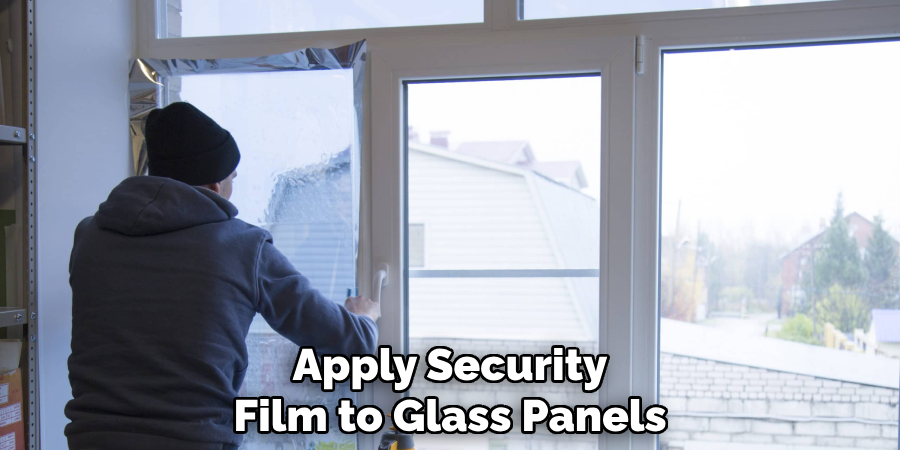
With these additional tips and tricks, you can further secure your outward-opening door and protect your home from potential intruders.
5 Things You Should Avoid
- Neglecting the Quality of Locks: Avoid opting for cheap or low-quality locks. Investing in high-grade security locks is crucial for the integrity of an outward-opening door. Low-quality locks are easily tampered with, compromising your door’s security.
- Ignoring the Door’s Material: Do not overlook the material of your door. Weak or flimsy materials can negate any security measures you put in place. Ensure your door is made of solid wood, metal, or a similarly sturdy material that resists forced entry.
- Overlooking the Importance of Professional Installation: Trying to install security features yourself without proper knowledge or tools can lead to vulnerabilities. Professional installation ensures that security devices such as deadbolts, hinges, and frame strengtheners are installed correctly.
- Using Short Screws in Hinges and Strike Plates: Avoid using the short screws that often come with locks and hinge hardware. These do not anchor securely into the door frame or wall studs. Use long screws that reach deeper, providing a much stronger hold against force.
- Forgetting to Secure Auxiliary Entry Points: Focusing solely on the door itself while neglecting other entry points like windows or secondary doors can leave your home vulnerable. Ensure all potential entry points are secured to provide a comprehensive security solution for your home.
By avoiding these common mistakes, you can ensure that your outward opening door is adequately secured and provides optimal protection for your home.
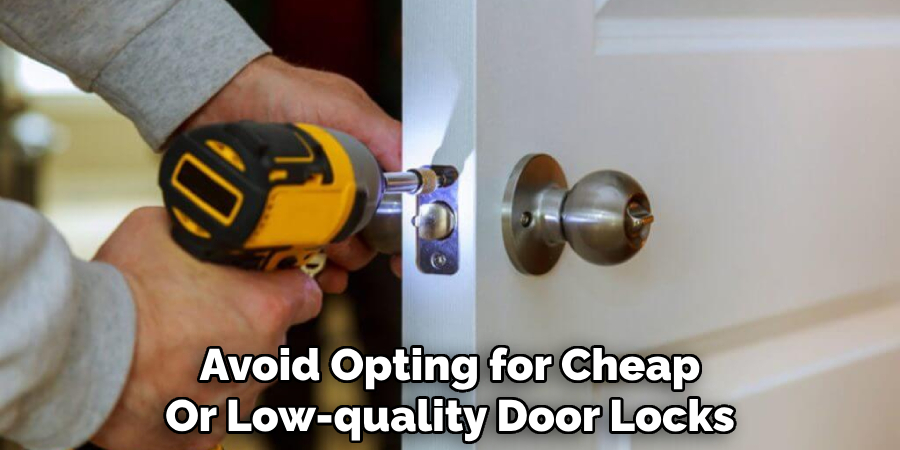
Can Stable Doors Open Outwards?
Yes, stable doors can open outward. In fact, many traditional stable doors were designed to open outwards as it made it easier for horses and other livestock to enter and exit the stable. However, there are also variations of stable doors that open inward or have a combination of both inward and outward opening components.
When it comes to security, the direction in which a door opens does not affect its overall strength and resistance against forced entry. It is more important to ensure that the door is made of sturdy materials and installed with high-quality locks and security features.
Overall, outward opening doors can provide added functionality and convenience in certain situations, but they require extra attention when it comes to security.
Conclusion
Securing an outward opening door involves a combination of high-quality hardware, robust materials, and professional installation. By implementing the tips and avoiding the common pitfalls outlined above, homeowners can significantly enhance the security of their outward opening doors. Investing in strong locks, reinforcing the door frame and hinges, and paying attention to the importance of the door’s material and professional installation is critical.
Additionally, auxiliary entry points should also be secured to ensure comprehensive protection. Employing these strategies will make it considerably more challenging for intruders to compromise your home’s security, offering peace of mind and safeguarding your property and loved ones. Remember, the goal is not only to deter potential burglars but to create multiple layers of security that work together to protect your home effectively.
Hopefully, the article on how to secure an outward opening door has provided useful insights and actionable steps for homeowners to implement. The end result will be a safer home and increased peace of mind for you and your family. Stay safe!
About
Safety Fic is a distinguished figure in the world of Diy design, with a decade of expertise creating innovative and sustainable Diy solutions. His professional focus lies in merging traditional craftsmanship with modern manufacturing techniques, fostering designs that are both practical and environmentally conscious. As the author of diy, Safety Fic delves into the art and science of Safety Fic-making, inspiring artisans and industry professionals alike.
Education RMIT University
(Melbourne, Australia) Associate Degree in Design (Safety Fic) Focus on sustainable design, industry-driven projects, and practical craftsmanship. Gained hands-on experience with traditional and digital manufacturing tools, such as CAD and CNC software.
Nottingham Trent University
(United Kingdom) Bachelor’s in diyfastly.com and Product Design (Honors) Specialized in product design with a focus on blending creativity with production techniques. Participated in industry projects, working with companies like John Lewis and Vitsoe to gain real-world insights.
Publications and Impact
In diy, Safety Fic his insights on indoor design processes, materials, and strategies for efficient production. His writing bridges the gap between artisan knowledge and modern industry needs, making it a must-read for both budding designers and seasoned professionals.
